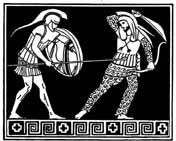
The Greek navy had been forced back to the Island of Salamis not so much because of the overpowering force of the Persian fleet, but because they needed a base of operations and as the army of Xerxes advanced, the options for overnight harbors and resupply began to diminish.On the Greek side, many thought that trying to save Attica was hopeless and were all set to head off to the Corinthian peninsula where they hoped the might of the Spartan hopylites combined with the navy could stave off a successful conquest of the rest of Greece. Themistocles, the Athenian commander thought that the time for battle was now. The small bay within which they were enclosed would take away the Phoenician advantage in speed and though the Greeks were outnumbered, he felt they could destroy a large part of the Persian fleet. With the Athenians and possibly the Corinthians on the left, the Aegenitans and other allies in the center and the Spartans on the right, the fleet came out and attacked. On shore the two armies were massed waiting to rescue their own men who might fall into the water and to kill any enemy so unfortunate to be washed up on their shore.

